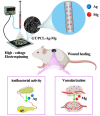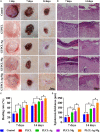Metallic Ions Encapsulated in Electrospun Nanofiber for Antibacterial and Angiogenesis Function to Promote Wound Repair
- PMID: 33842486
- PMCID: PMC8027477
- DOI: 10.3389/fcell.2021.660571
Metallic Ions Encapsulated in Electrospun Nanofiber for Antibacterial and Angiogenesis Function to Promote Wound Repair
Retraction in
-
Retraction: Metallic ions encapsulated in electrospun nanofiber for antibacterial and angiogenesis function to promote wound repair.Front Cell Dev Biol. 2022 Oct 11;10:1058556. doi: 10.3389/fcell.2022.1058556. eCollection 2022. Front Cell Dev Biol. 2022. PMID: 36303607 Free PMC article.
Abstract
Electrospun nanofiber is an attractive biomaterial for skin tissue engineering because it mimics the natural fibrous extracellular matrix structure and creates a physical structure suitable for skin tissue regeneration. However, endowing the nanofibrous membranes with antibacterial and angiogenesis functions needs to be explored. In the current study, we aimed to fabricate gelatin/polycaprolactone (GT/PCL) (GT/PCL-Ag-Mg) nanofibers loaded with silver (Ag) and magnesium (Mg) ions for antibacterial activity and pro-angiogenesis function for wound repair. The fabricated GT/PCL membranes had a nanofibrous structure with random arrangement and achieved sustained release of Ag and Mg ions. In vitro results indicated that the GT/PCL-Ag-Mg membranes presented satisfactory cytocompatibility with cell survival and proliferation. In addition, the membranes with Ag demonstrated good antibacterial capacity to both gram-positive and gram-negative bacteria, and the Mg released from the membranes promoted the tube formation of vascular endothelial cells. Furthermore, in vivo results demonstrated that the GT/PCL-Ag-Mg membrane presented an accelerated wound healing process compared with GT/PCL membranes incorporated with either Ag or Mg ions and pure GT/PCL alone. Superior epidermis formation, vascularization, and collagen deposition were also observed in GT/PCL-Ag-Mg membrane compared with the other membranes. In conclusion, a multifunctional GT/PCL-Ag-Mg membrane was fabricated with anti-infection and pro-angiogenesis functions, serving as a potential metallic ion-based therapeutic platform for applications in wound repair.
Keywords: angiogenesis; antibacterial; electrospinning; magnesium; silver; wound healing.
Copyright © 2021 Zhu, Cao, Zhang and Chen.
Conflict of interest statement
The authors declare that the research was conducted in the absence of any commercial or financial relationships that could be construed as a potential conflict of interest.
Figures







Similar articles
-
Human urine-derived stem cells in combination with polycaprolactone/gelatin nanofibrous membranes enhance wound healing by promoting angiogenesis.J Transl Med. 2014 Oct 2;12:274. doi: 10.1186/s12967-014-0274-2. J Transl Med. 2014. PMID: 25274078 Free PMC article.
-
Incorporation of magnesium oxide nanoparticles into electrospun membranes improves pro-angiogenic activity and promotes diabetic wound healing.Biomater Adv. 2022 Feb;133:112609. doi: 10.1016/j.msec.2021.112609. Epub 2021 Dec 14. Biomater Adv. 2022. PMID: 35525752
-
In vitro cytotoxicity and antibacterial activity of silver-coated electrospun polycaprolactone/gelatine nanofibrous scaffolds.3 Biotech. 2016 Dec;6(2):211. doi: 10.1007/s13205-016-0531-6. Epub 2016 Sep 29. 3 Biotech. 2016. PMID: 28330282 Free PMC article.
-
Electrospun Polycaprolactone Nanofibers: Current Research and Applications in Biomedical Application.Adv Pharm Bull. 2022 Aug;12(4):658-672. doi: 10.34172/apb.2022.070. Epub 2021 Oct 3. Adv Pharm Bull. 2022. PMID: 36415646 Free PMC article. Review.
-
Electrospun nanofibrous membranes meet antibacterial nanomaterials: From preparation strategies to biomedical applications.Bioact Mater. 2024 Sep 11;42:478-518. doi: 10.1016/j.bioactmat.2024.09.003. eCollection 2024 Dec. Bioact Mater. 2024. PMID: 39308550 Free PMC article. Review.
Cited by
-
Bioactive glass 1393 promotes angiogenesis and accelerates wound healing through ROS/P53/MMP9 signaling pathway.Regen Ther. 2024 May 31;26:132-144. doi: 10.1016/j.reth.2024.05.016. eCollection 2024 Jun. Regen Ther. 2024. PMID: 38872979 Free PMC article.
-
Electrospinning of Potential Medical Devices (Wound Dressings, Tissue Engineering Scaffolds, Face Masks) and Their Regulatory Approach.Pharmaceutics. 2023 Jan 26;15(2):417. doi: 10.3390/pharmaceutics15020417. Pharmaceutics. 2023. PMID: 36839739 Free PMC article. Review.
-
Nanomaterials in Skin Regeneration and Rejuvenation.Int J Mol Sci. 2021 Jun 30;22(13):7095. doi: 10.3390/ijms22137095. Int J Mol Sci. 2021. PMID: 34209468 Free PMC article. Review.
-
Stem Cell-Based Therapy: A Promising Treatment for Diabetic Foot Ulcer.Biomedicines. 2022 Jun 25;10(7):1507. doi: 10.3390/biomedicines10071507. Biomedicines. 2022. PMID: 35884812 Free PMC article. Review.
-
Electrospun polycaprolactone nanofibrous membranes loaded with baicalin for antibacterial wound dressing.Sci Rep. 2022 Jun 28;12(1):10900. doi: 10.1038/s41598-022-13141-0. Sci Rep. 2022. PMID: 35764658 Free PMC article.
References
Publication types
LinkOut - more resources
Full Text Sources
Other Literature Sources
Miscellaneous

